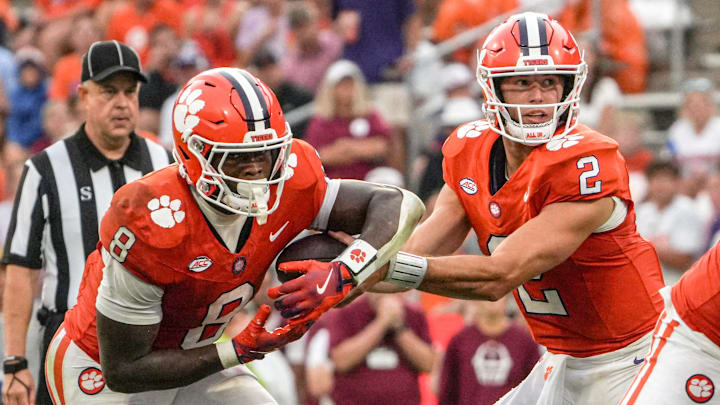It’s only two games. Keep reminding yourself that it's a very small sample size, because Clemson, in theory, should get much better as the season goes along.
Those contests were against one excellent team (LSU) and one team (Troy) that the Tigers should’ve beaten by much more than 11 points.
While the defense hasn’t been perfect, it’s only given up three touchdowns through two games. The real issue is on the scoring side of the ball. Obviously, your eyes can see it: Cade Klubnik’s uncomfortable in the pocket. They all miss Antonio Williams. The offensive line should be better. The running game isn’t being used correctly or enough.
Those thoughts feel fairly universal, but what do the numbers say? Even though you don’t always need surface stats and advanced metrics to tell you things are not going well on that side of the ball, numbers can confirm what you're seeing and where the Tigers need to improve the most.
Basic offensive stats
These are your typical surface numbers that help you understand the big picture and compare the Tigers to everybody else. It’s important to remember that very few of the 136 FBS teams have played an opponent as strong as LSU, and there are more important stats than others, but let’s dive into them anyway (national ranking in parentheses):
Total offense: 288.5 yards per game (120th)
Scoring offense: 18.5 points per game (110th)
Touchdowns scored: 4 (118th)
Yards per play: 5.11 (95th)
Plays run per game: 56.5 (125th)
Plays over 20+ yards: 8 (73rd)
Rushing yards per play: 2.96 (125th)
Yards per pass: 6.9 (85th)
First downs per game: 15 (122nd)
Third-down conversions: 32% (108th)
Sacks allowed: 3 (54th)
Red-zone conversion rate: 80% (91st)
Red-zone TD conversion rate: 40% (115th)
*Stats from CFBstats.
Summary: Ranking inside or near the 100s in nearly every important surface stat is a really bad sign. However, these rankings can improve quickly with a couple of outstanding performances. Still, the most concerning figures are the yards per play, third-down conversions, and rushing yards per play. Those stats aren’t sustainable if you want to win games.
Deeper analytics
These figures can be much more confusing, but are correlated more to wins and losses than some of the surface stats. The big one here is Expected Points Added (EPA), a measure of how a play changes a team’s probability of scoring. Plus is good for an offense. Minus is bad. It’s the opposite for defense.
EPA uses factors like down and distance, field position, home-field advantage, and others. Popularized as a better metric than yards per game or play in the NFL, college football has adopted the metric and other analytics to basically tell us if a team is good or not. Let’s see where Clemson’s offense ranks:
Total EPA: -19.87 (121st)
EPA per play: -0.18 (126th)
EPA per game: -9.94 (121st)
Overall success rate: 39.8 (92nd)
EPA passing: -6.30 (99th)
EPA per play passing: -0.10 (99th)
Passing success rate: 40% (91st)
EPA rushing: -13.57 (124th)
EPA per play rushing: -0.28 (129th)
Rushing success rate: 39.6% (85th)
Explosive rate: 9.7 (70th percentile)
*Stats from GameOnPaper.
Summary: There’s not a lot surprising here, other than seeing just how bad the Tigers rank in some incredibly important metrics, like EPA per play and EPA per rush. These analytics aren’t much different than the traditional stats listed above in terms of where Clemson’s offense ranks nationally in numerous categories. If anything, the advanced metrics paint a tad worse picture with EPA being so low compared to other teams.
The overall success rate is inside the 100s, giving the Tigers hope that they can turn that around quickly. Still, the statistical picture is painted as poorly as the product you’re seeing on the field.
